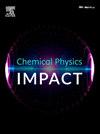Red emission in MoO3:Eu3+ nanobelts: Investigation on the photoluminescence quenching mechanism
IF 4.3
Q2 CHEMISTRY, PHYSICAL
引用次数: 0
Abstract
MoO3:Eu3+ nanobelts were synthesized via the hydrothermal method with varying concentrations of europium doping. The investigation has examined the structural, morphological, optical, and photoluminescence characteristics of MoO3:Eu3+ nanophosphors. The XRD and Raman spectroscopy affirmed the orthorhombic structure of the synthesized nanostructures. FESEM depicts a nanobelt-like morphology and XPS studies confirmed the presence of Eu3+. A detailed analysis of the photoluminescence mechanism, concentration quenching, and quantum efficiency is presented in this study. Upon 302 nm excitation, red emission was observed along with concentration quenching effects. The optimized sample with the highest PL intensity (MoO3:Eu3+ 3 mol. %) was annealed at 600 °C for 12 hrs. The PL intensity increased upon annealing, with the corresponding CIE coordinates (0.52, 0.29). The findings highlight the material's potential for use in display technologies and bioimaging phosphors.

MoO3:Eu3+纳米带的红光发射:光致发光猝灭机理的研究
采用水热法制备了不同浓度铕掺杂的MoO3:Eu3+纳米带。研究了MoO3:Eu3+纳米荧光粉的结构、形态、光学和光致发光特性。XRD和拉曼光谱证实了合成的纳米结构具有正交结构。FESEM描述了纳米带状形貌,XPS研究证实了Eu3+的存在。本文详细分析了光致发光机理、浓度猝灭和量子效率。在302 nm激发下,观察到红色发射和浓度猝灭效应。优化后的样品PL强度最高(MoO3:Eu3+ 3 mol. %),在600℃下退火12 h。退火后发光强度增加,对应CIE坐标(0.52,0.29)。这一发现突出了该材料在显示技术和生物成像荧光粉方面的应用潜力。
本文章由计算机程序翻译,如有差异,请以英文原文为准。
求助全文
约1分钟内获得全文
求助全文
来源期刊

Chemical Physics Impact
Materials Science-Materials Science (miscellaneous)
CiteScore
2.60
自引率
0.00%
发文量
65
审稿时长
46 days
 求助内容:
求助内容: 应助结果提醒方式:
应助结果提醒方式:


